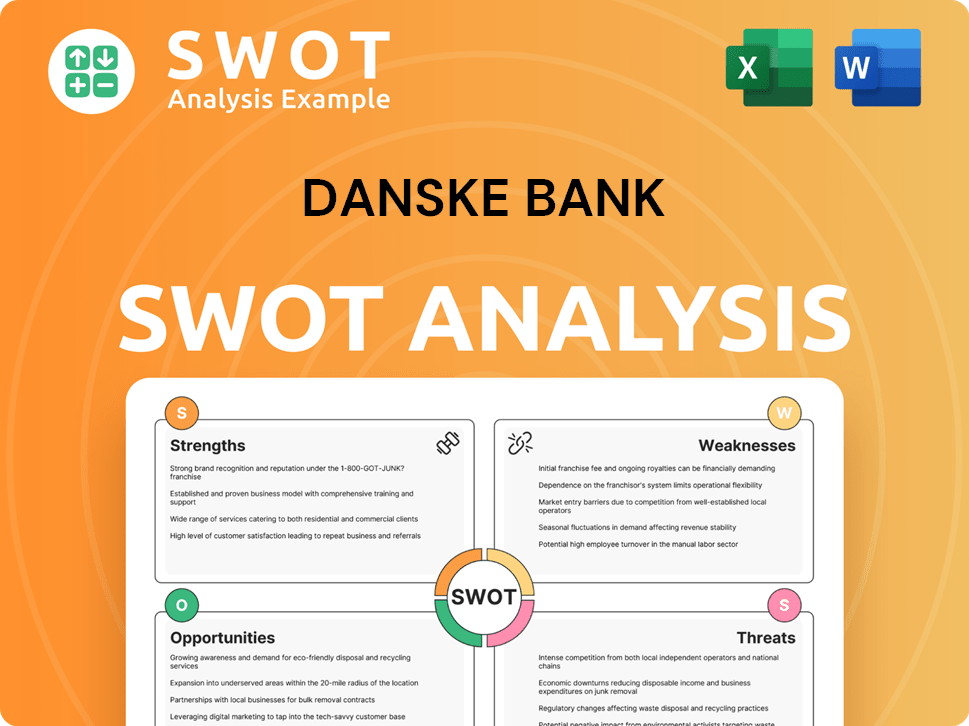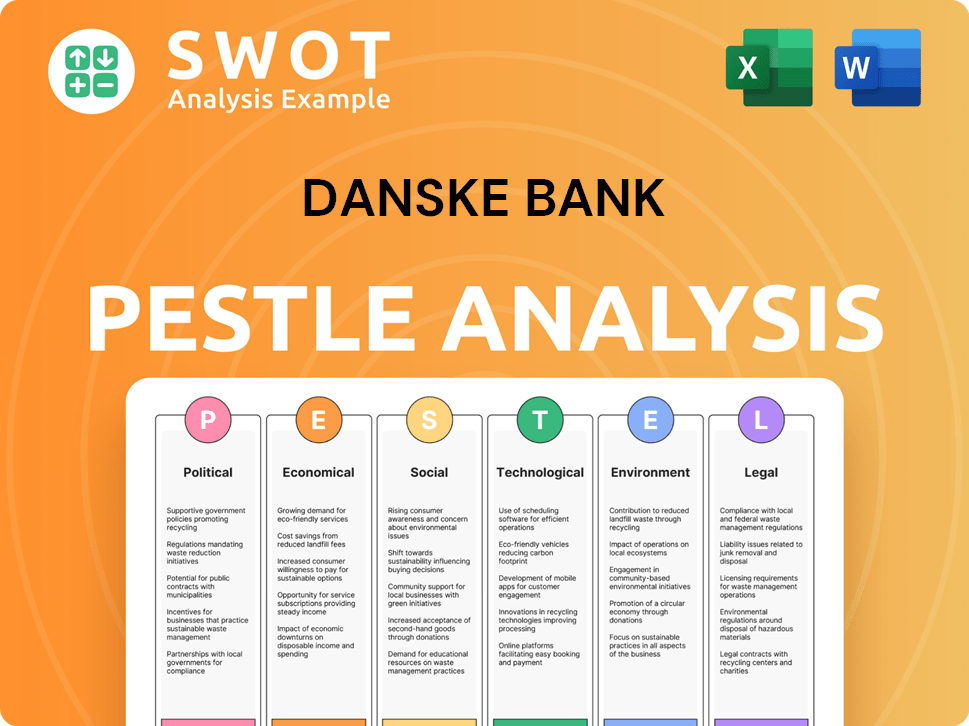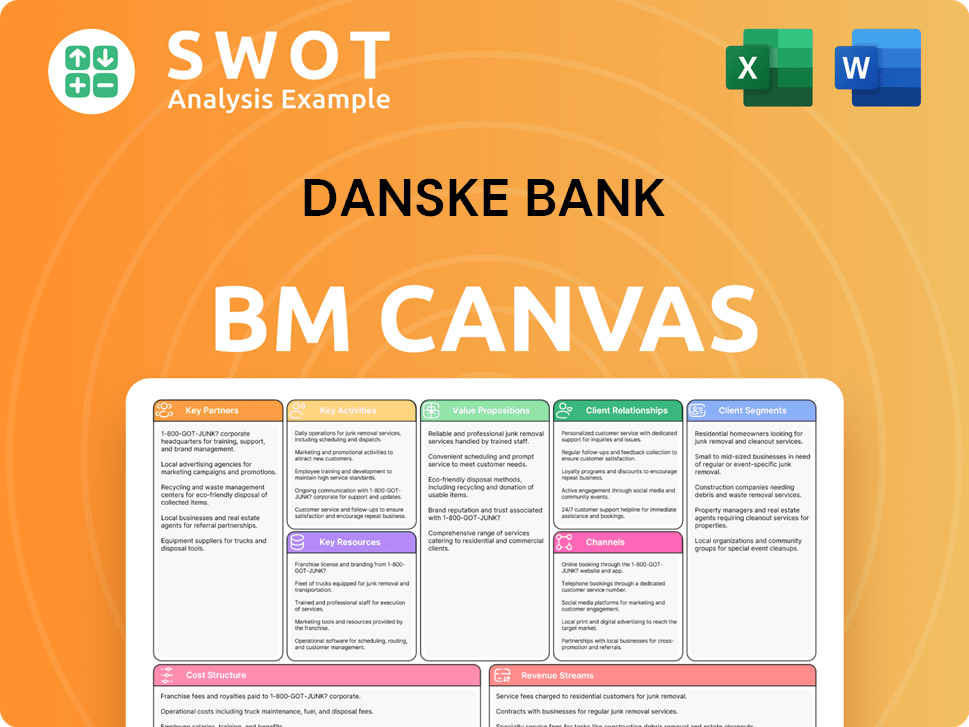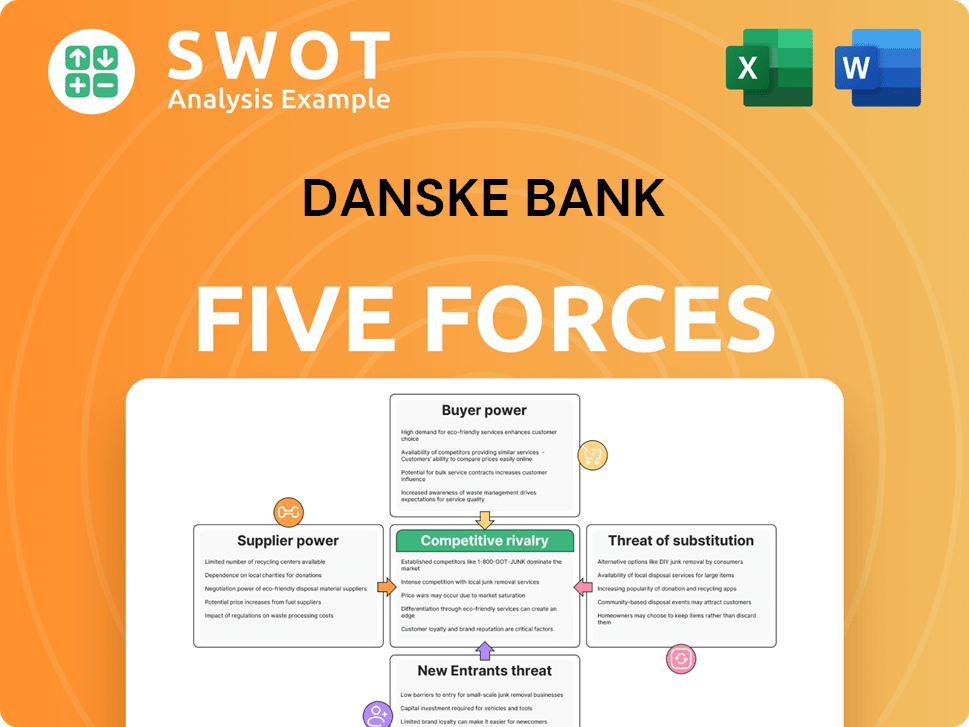Danske Bank Bundle
How Does Danske Bank Navigate the Cutthroat Banking Arena?
The Nordic banking sector is a crucible of innovation and competition, forcing established institutions to constantly adapt. Danske Bank, a stalwart of the Danish financial system, faces a complex web of rivals in this dynamic environment. Understanding the Danske Bank SWOT Analysis is crucial to grasping its position.

This analysis dives deep into the Danske Bank competitive landscape, examining its key rivals and dissecting its market share analysis. We'll explore the financial services competition, providing a comprehensive banking industry analysis. Uncover Danske Bank's competitive advantages and how its business strategy analysis positions it against competitors like Nordea and Swedbank, offering insights into the Danish banking sector.
Where Does Danske Bank’ Stand in the Current Market?
Danske Bank holds a significant position within the Nordic banking industry, particularly in its home market of Denmark. The bank's core operations encompass a broad spectrum of financial services, including loans, mortgages, investment products, and insurance, catering to both personal and business customers. This diverse offering allows Danske Bank to serve a wide customer base and generate revenue from multiple sources.
The value proposition of Danske Bank centers on providing comprehensive financial solutions and maintaining a strong presence in the Nordic region. They focus on customer experience and operational efficiency. The bank's commitment to digital transformation reflects a broader industry trend towards digitalization, aimed at enhancing customer service and streamlining operations. The Revenue Streams & Business Model of Danske Bank highlights the bank's multifaceted approach to generating income and creating value for its stakeholders.
As of the first quarter of 2024, Danske Bank reported a net profit of DKK 5.6 billion, demonstrating its strong financial health. Its geographic presence is concentrated in Denmark, Norway, Sweden, and Finland, with Denmark representing its largest market share. While specific market share figures for all segments across all Nordic countries can fluctuate, Danske Bank consistently ranks among the top-tier banks in the region.
Danske Bank maintains a particularly strong position in Denmark. The bank's market share in its home market is substantial, reflecting its established presence and customer loyalty. This strong foothold provides a solid foundation for its overall financial performance and competitive advantage within the Danish banking sector.
Danske Bank has invested heavily in digital platforms and services. These initiatives aim to enhance customer experience and streamline operations. The bank's digital efforts are crucial in maintaining its competitive edge in a rapidly evolving financial landscape. This focus on technology reflects the broader trend of digitalization within the banking industry.
Danske Bank faces intense competition in other Nordic markets like Sweden and Norway. The competitive dynamics vary across different segments and countries. Understanding the competitive landscape is essential for the bank's strategic planning and market positioning. The bank must continually adapt to maintain its market share.
Danske Bank's financial performance, as evidenced by its Q1 2024 results, positions it favorably compared to many industry averages. The bank's ability to generate strong profits and maintain a solid financial standing is crucial for its long-term success. This financial health supports its ability to invest in growth and navigate market challenges.
Danske Bank's market position is shaped by several key factors, including its strong presence in Denmark, its investments in digital transformation, and its overall financial performance. These elements contribute to its competitive advantages and ability to serve its customers effectively.
- Strong Market Share in Denmark: Danske Bank holds a dominant position in its home market.
- Digital Transformation: Investment in digital platforms enhances customer experience and efficiency.
- Financial Health: Demonstrated by strong Q1 2024 results, indicating profitability and stability.
- Geographic Focus: Primarily operates in Denmark, Norway, Sweden, and Finland.
Danske Bank SWOT Analysis
- Complete SWOT Breakdown
- Fully Customizable
- Editable in Excel & Word
- Professional Formatting
- Investor-Ready Format

Who Are the Main Competitors Challenging Danske Bank?
The Growth Strategy of Danske Bank is heavily influenced by the competitive dynamics of the Nordic banking sector. Danske Bank faces a complex competitive landscape, characterized by both direct and indirect competitors vying for market share across various segments. Understanding these competitors and their strategies is crucial for Danske Bank to maintain and enhance its market position.
The competitive pressures stem from established players, emerging fintech companies, and evolving customer expectations. These factors necessitate continuous adaptation and innovation in product offerings, pricing strategies, and digital capabilities. The bank's ability to navigate this landscape will significantly impact its financial performance and long-term sustainability.
Danske Bank's competitive landscape is shaped by several key players and emerging trends. The bank competes with both traditional financial institutions and newer, technology-driven firms. This section provides an overview of the main competitors, their strategies, and the challenges they pose to Danske Bank.
The most significant direct competitors to Danske Bank include Nordea, SEB, Swedbank, and DNB. These institutions offer a broad range of financial services across the Nordic region, competing for both retail and corporate clients.
Nordea is a major pan-Nordic financial services group, posing a significant challenge to Danske Bank across all key markets. Nordea's extensive geographic reach and strong digital presence are key competitive advantages. In 2023, Nordea reported a net profit of approximately EUR 4.2 billion, highlighting its robust financial performance.
SEB and Swedbank are strong competitors, particularly in Sweden. They have established market shares and are known for their robust digital offerings. Both banks focus heavily on customer experience and innovation to maintain their competitive edge. Swedbank's net profit for 2023 was about SEK 22.9 billion.
DNB is a leading player in Norway, presenting a significant challenge in that market. DNB's strong domestic presence and focus on customer relationships contribute to its competitive standing. DNB reported a profit before tax of NOK 40.3 billion in 2023.
Beyond the major Nordic banks, Danske Bank also faces competition from smaller, specialized banks and fintech companies. These entities often leverage technology to offer niche products, lower costs, and disrupt traditional banking models.
Fintech companies are increasingly impacting the banking industry by offering innovative solutions. These companies often focus on specific areas like payments, lending, or wealth management. The rise of digital banking and mobile payment solutions poses a threat to traditional banks.
The competitive landscape is dynamic, with banks constantly adapting their strategies to maintain market share. Key competitive factors include pricing, innovation, digital capabilities, and customer service. Danske Bank must continually invest in these areas to remain competitive.
- Digital Transformation: Banks are investing heavily in digital platforms and services to enhance customer experience and operational efficiency.
- Pricing Strategies: Competitive pricing on loans, deposits, and other financial products is crucial for attracting and retaining customers.
- Innovation: Continuous innovation in products and services, including new technologies and features, is essential.
- Customer Service: Providing excellent customer service is vital for building loyalty and differentiating from competitors.
Danske Bank PESTLE Analysis
- Covers All 6 PESTLE Categories
- No Research Needed – Save Hours of Work
- Built by Experts, Trusted by Consultants
- Instant Download, Ready to Use
- 100% Editable, Fully Customizable

What Gives Danske Bank a Competitive Edge Over Its Rivals?
Understanding the Brief History of Danske Bank is crucial for assessing its competitive advantages. Danske Bank, a significant player in the Nordic banking sector, holds several key strengths that differentiate it from its competitors. These advantages are essential for navigating the complex landscape of the banking industry analysis and maintaining a strong market position.
Danske Bank's competitive edge is built upon a foundation of robust financial performance and strategic initiatives. The bank's focus on digital transformation, customer experience, and operational efficiency has allowed it to adapt to the evolving demands of the financial services competition. This strategic approach is critical for ensuring sustained growth and profitability in the Danish banking sector and beyond.
The bank's enduring brand equity and established presence in the Nordic region, particularly in Denmark, are key differentiators. This solid reputation fosters customer trust and loyalty, providing a competitive advantage in attracting and retaining customers. In the context of Danske Bank competitive landscape, understanding these core strengths is vital for investors, analysts, and strategists.
Danske Bank benefits from a well-established brand and a long-standing presence in the Nordic region. This strong brand equity fosters customer trust and loyalty, providing a solid foundation for its operations. Its established market presence helps in maintaining a competitive edge within the financial services competition.
The bank's large scale allows for efficient operations and competitive pricing across its diverse product portfolio. This efficiency is crucial in the competitive landscape. Economies of scale enable Danske Bank to offer a wide range of products, including loans, mortgages, and investment products, at competitive rates.
Danske Bank has invested significantly in digital transformation to enhance customer experience and operational efficiency. This strategic focus on developing robust digital platforms is becoming a crucial competitive differentiator. The bank's digital initiatives are designed to streamline processes and provide more personalized offerings.
Danske Bank's broad distribution network, encompassing both physical branches and digital channels, ensures wide customer reach. This extensive network supports customer accessibility and convenience. The bank's ability to serve customers through multiple channels is a key competitive advantage.
Danske Bank's competitive advantages are multifaceted, encompassing brand strength, operational efficiency, and digital innovation. The bank's strategic focus on customer experience and market understanding supports its ability to compete effectively. Understanding Danske Bank competitors is essential for any market analysis.
- Strong Brand Equity: Danske Bank's established brand in the Nordic region fosters customer trust and loyalty.
- Digital Investments: Significant investments in digital platforms enhance customer experience and operational efficiency.
- Comprehensive Network: A broad distribution network ensures wide customer reach through both physical and digital channels.
- Market Understanding: Deep understanding of the Nordic markets allows for tailored products and services.
Danske Bank Business Model Canvas
- Complete 9-Block Business Model Canvas
- Effortlessly Communicate Your Business Strategy
- Investor-Ready BMC Format
- 100% Editable and Customizable
- Clear and Structured Layout

What Industry Trends Are Reshaping Danske Bank’s Competitive Landscape?
The Danske Bank competitive landscape is significantly shaped by industry trends, potential risks, and future opportunities. The banking industry analysis reveals a dynamic environment driven by technological advancements, evolving regulations, and changing consumer behaviors. Understanding these elements is crucial for assessing Danske Bank's position and formulating effective strategies. This analysis offers insights into the challenges and opportunities that will influence the bank's performance.
The Danske Bank market analysis indicates that the bank faces both internal and external pressures. Internal challenges include adapting to new digital banking initiatives and managing its existing infrastructure. External factors involve heightened competition from fintechs and larger tech firms, as well as stricter regulatory demands. This analysis aims to provide a comprehensive view of the competitive environment in which Danske Bank operates.
Digitalization continues to be a dominant trend, with banks investing in AI, data analytics, and cloud computing. The regulatory landscape is evolving, particularly in areas like AML and sustainable finance. Consumer preferences are shifting towards more convenient, personalized, and environmentally conscious banking services. These trends require continuous adaptation to remain competitive.
Increased competition from fintechs and large tech firms poses a significant threat. Pressure on interest margins and the need to adapt to stricter regulatory requirements are ongoing challenges. Managing reputational risks associated with past issues remains critical. These challenges require strategic agility and proactive risk management.
Leveraging digital investments to innovate and expand digital offerings is a key opportunity. The growing demand for sustainable finance provides a chance to develop green financial products. Strategic partnerships with fintechs can unlock new growth avenues. These opportunities can drive growth and enhance market position.
Danske Bank needs to effectively navigate these trends, leveraging technology and adapting its business model. Focus on customer experience and personalized services is essential. Continuous innovation and strategic partnerships are vital for long-term success. These considerations are crucial for maintaining a competitive edge.
The Danish banking sector is influenced by global economic conditions and local market dynamics. The financial services competition is intensifying, with traditional banks facing challenges from new entrants and evolving consumer expectations. Understanding the competitive landscape requires close examination of key rivals and strategic responses.
- Danske Bank competitors include Nordea, Swedbank, and other regional and international players.
- Recent acquisitions and mergers within the industry are reshaping the competitive environment.
- Digital banking initiatives are critical for attracting and retaining customers.
- Geographic presence and customer base analysis are essential for strategic decisions.
- Owners & Shareholders of Danske Bank need to understand these dynamics.
Danske Bank Porter's Five Forces Analysis
- Covers All 5 Competitive Forces in Detail
- Structured for Consultants, Students, and Founders
- 100% Editable in Microsoft Word & Excel
- Instant Digital Download – Use Immediately
- Compatible with Mac & PC – Fully Unlocked

Related Blogs
- What are Mission Vision & Core Values of Danske Bank Company?
- What is Growth Strategy and Future Prospects of Danske Bank Company?
- How Does Danske Bank Company Work?
- What is Sales and Marketing Strategy of Danske Bank Company?
- What is Brief History of Danske Bank Company?
- Who Owns Danske Bank Company?
- What is Customer Demographics and Target Market of Danske Bank Company?
Disclaimer
All information, articles, and product details provided on this website are for general informational and educational purposes only. We do not claim any ownership over, nor do we intend to infringe upon, any trademarks, copyrights, logos, brand names, or other intellectual property mentioned or depicted on this site. Such intellectual property remains the property of its respective owners, and any references here are made solely for identification or informational purposes, without implying any affiliation, endorsement, or partnership.
We make no representations or warranties, express or implied, regarding the accuracy, completeness, or suitability of any content or products presented. Nothing on this website should be construed as legal, tax, investment, financial, medical, or other professional advice. In addition, no part of this site—including articles or product references—constitutes a solicitation, recommendation, endorsement, advertisement, or offer to buy or sell any securities, franchises, or other financial instruments, particularly in jurisdictions where such activity would be unlawful.
All content is of a general nature and may not address the specific circumstances of any individual or entity. It is not a substitute for professional advice or services. Any actions you take based on the information provided here are strictly at your own risk. You accept full responsibility for any decisions or outcomes arising from your use of this website and agree to release us from any liability in connection with your use of, or reliance upon, the content or products found herein.